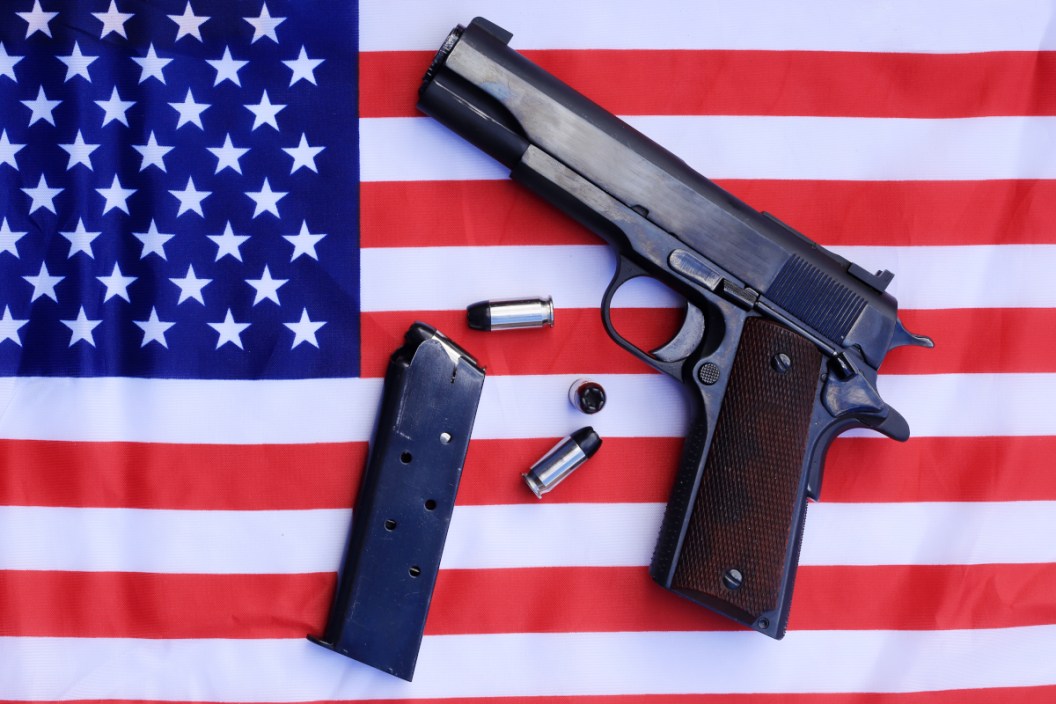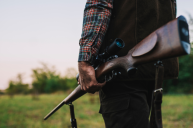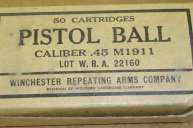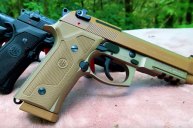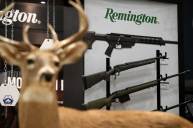Here are the origins of the classic 1911 pistol.
When it comes to American firearms history, the Browning 1911 pistol will go down as one of the most iconic designs of all time. John M. Browning's simple but highly effective design has seen combat in almost every major war since World War I.
It is safe to say modern firearms would probably look quite different had the Colt Model 1911 not been there to inspire future designers.
Today, versions of this single-action semi-auto pistol are sold by almost every major gun manufacturer as one of the most popular self-defense options. Here is how it all got started.
Browning's history
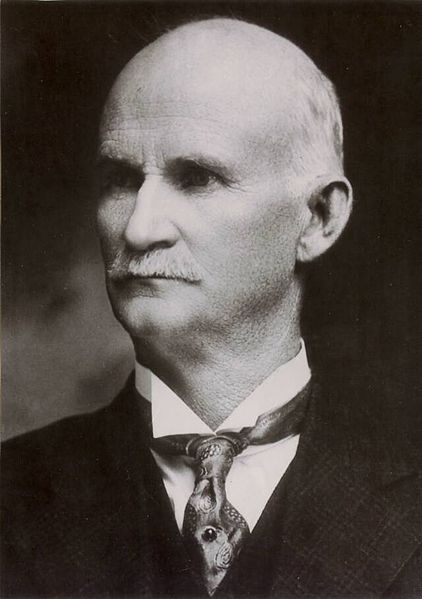
Wikimedia Commons: unknown/Browning
John Browning got his start in firearms while working in his father's gun shop in Ogden, Utah. Today, the city is home to an awesome firearms museum in his name (Seriously, check it out if you're ever in the area).
Browning first made a name for himself by designing a falling block rifle later purchased by Winchester and named the Winchester 1885, a gun iconic to the later days of the Old West.
Winchester recognized Browning's talent and continued to work with him. Soon after that he developed the popular Model 1887, 1897 and Browning A-5 shotguns. He was also responsible for incredibly famous lever-action rifles like the Model 1894.
Around the same time Browning was launching his legendary Browning A-5 shotgun in the early 1900s with the help of Belgium-based FN Herstal, the Army was looking for new centerfire combat-style handgun options. Browning came up with the perfect design.
A need for a semi-automatic handgun
A few different historical things spurred the Army's need for a new sidearm.
One of those was a lesser-known conflict: the Philippine-American War. It lasted from 1899 to 1902 and came about as a result of the U.S. taking title of the Philippines through the Treaty of Paris.
Most residents of the Philippines weren't too happy with the idea of the U.S. taking possession of their islands, especially the Moro tribesmen on some of the southern islands. They began a fierce series of conflicts against American forces. The fighting was close-quarters jungle combat, and top Army officials quickly realized the double-action revolvers troops were outfitted with were ill-suited for the job.
When it was discovered that the Moro were using drugs to block out the pain of the smaller rounds, and that was seemingly the last straw. In response to reports of the Moro taking multiple .38 rounds and continuing to fight, the Army sent some older-model .45 caliber Colt revolvers to the Philippines, and that solved the problem.
However, after that the Army realized they needed significantly more firepower in their pistols. They conducted a lot of testing before deciding they wanted to ditch the revolver completely and adopt a semi-automatic that fired Browning's new .45 ACP cartridge (Automatic Colt Pistol). That round was a modification of a .41 caliber round Browning had been working on with the Army in 1905.
In 1906, the Army had a field of six potential contenders for their new service pistol, with what would later become the Model 1911 among them. The field of candidates was narrowed to three, including designs from Savage and Deutsche Waffen und Munition (DWR). Interestingly, the design DWR submitted was a modified Luger, but they withdrew from the testing. The Luger later became the service semi-automatic pistol of choice for the German armies.
Four years of testing
From 1907 to 1911, the Army torture-tested the Browning and Savage designs. These tests were the downfall of Savage. Their design had 37 malfunctions over the course of testing to the 1911's zero. It does not get much more clear than that!
One legendary story about this testing is one stretch of shooting in which over 6,000 rounds were put through both pistols in the course of just a few days. The story says the testers began dunking the 1911 in water to cool it off. After that, the pistol kept firing with no issues!
As if that wasn't enough, Army officials were equally impressed by the gun's trigger pull, recoil spring, manual and grip safety system, its stainless steel slide and steel magazine and of course, the gun's accuracy, thanks largely to its barrel length.
All of these intangibles made for an easy decision by the Army, and the .45 ACP handgun was adopted as the Army's service handgun of choice in March of 1911. It came just in time, too, because a number of major world conflicts were brewing.
Proven in combat
The 1911 first saw combat in 1916 after Mexican revolutionary Pancho Villa made the mistake of attacking New Mexico and Texas. President Woodrow Wilson sent 5,000 American troops south of the border into Mexico to find him.
They didn't capture Villa, but the 1911 proved itself in combat, which was a good thing. Just a few years later, World War I broke out.
In at least two instances, the 1911 was used by Medal of Honor winners in the Great War. The most notable of these encounters was Sergeant Alvin York, who led a charge on a German machine gun position in October of 1918. When York ran out of ammo in his service rifle while attacking the position, he still had six soldiers coming at him. He took all six out with a Model 1911.
Considering that the pistol has a seven-round magazine, that's some darn fine shooting under pressure!
This incident was later featured in the movie "Sergeant York" with Gary Cooper playing the title role. Amazingly, the 1911 didn't get the credit it deserved here. The gun Cooper uses in this scene is a Luger! We would like a word with the filmmakers on that one.
While the 1911 saw plenty of combat in "The Great War," it became a legend in World War II in the hands of Allied Forces. Nearly two million were sent overseas for the war effort.
In one particularly crazy story, a parachuting American pilot took down a Japanese airplane after shooting the pilot of the enemy plane in the head with a 1911 as the plane came back around for a second look.
Browning saw how his gun performed in World War I, but he didn't get to see how truly iconic it would become in the defense of the free world. He died in 1926.
Even though the Army eventually replaced the 1911 with the Beretta M9 in the 1980s, that's a pretty long service record! And, the 1911 hasn't been completely phased out. Some U.S. servicemen and women still use the gun, especially our U.S. Navy Seals.
The gun has seen many modifications and other variants over the years, but Browning's original design remains largely unchanged.
The 1911 today
This one legendary pistol has gained something of a second life in the last few decades, mainly with the increasing interest in firearms for personal defense. The single-stack magazine is the perfect slim profile for concealed carry of a full-size handgun. You will find plenty of people who trust this design over the most modern polymer Glocks. The 1911 is now built by many popular gun brands including Browning, Remington, Sig Sauer, Smith & Wesson, Springfield Armory, Kimber, and more.
Many gun manufacturers have improved on Browning's design with ambidextrous thumb safety systems, lighter materials and increased magazine capacities. Now the 1911 can be found in a variety of calibers all the way down to .380 ACP and .22 long rifle. Manufacturers have successfully downsized the design into more compact pistol designs. These carry pistols are easier to use for people with smaller hands. They also make the gun in a variety of finishes including stainless steel and matte black like the extremely popular Browning Black Label Medallion Pro .380 ACP pistol. These guns usually replace the traditional front sight and rear sight with advanced adjustable night sights perfect for low light conditions. The grip panels are usually re-designed to be even more ergonomic.
Many of these guns are now works of art thanks to beautiful and intricate rosewood grips and intricate engravings done by the world's most talented gunsmiths.
The world really could use more revolutionary designers like John Browning. We're sure he could have never predicted how his pistol would change the world AND still be in active use 110 years later!
For more outdoor content from Travis Smola, be sure to follow him on Twitter and check out his Geocaching and Outdoors with Travis YouTube channels.
NEXT: WHAT'S YOUR OLDEST PIECE OF HUNTING GEAR?
WATCH
